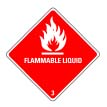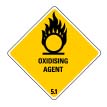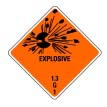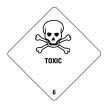An overview of the requirements for commercial transport operators who transport dangerous goods, and for couriers or any other person who transports dangerous goods for hire or direct reward.
This information applies to people who carry dangerous goods as a licensed transport service operator or for direct reward.
This information is an overview only. If your business involves transporting dangerous goods, you must refer directly to the Land Transport Rule: Dangerous Goods 2005 (the rule) for details. (Printed copies of the rule are available from selected bookshops that sell legislation and some libraries.)
Read the Land Transport Rule: Dangerous Goods 2005
More information about transporting dangerous goods as tools-of-trade
More information about transporting dangerous goods for domestic or recreational use
Dangerous goods for transport on land include substances and articles that have explosive, flammable, toxic, infectious, corrosive or environmentally hazardous properties, and containers that have held dangerous goods. All classes of dangerous goods are described in table A of the rule, which is based on classifications in the United Nations (UN) Recommendations on the transport of dangerous goods – model regulations.
Everyone involved in transporting dangerous goods has to comply with the rule. Responsibilities are allocated according to tasks, and you're responsible for all the tasks you do.
Consignors (manufacturers, importers or distributors) are responsible for:
Loaders are responsible for:
Drivers or operators of road vehicles are responsible for:
Drivers or operators of rail vehicles are responsible for:
Employers are responsible for:
Everyone involved is responsible for:
Anyone involved in transporting dangerous goods can ask that a package be opened to see if it contains dangerous goods, or refuse to handle or transport the package.
If you're a consignor, you must make sure the packaging is fit for its purpose, doesn't contaminate or react with the goods and is strong enough to hold the goods without leaking (under normal transport and handling conditions). Section 3 of the rule refers to packaging performance standards or the requirements of other New Zealand authorities. From the beginning of 2011, you must also comply with the UN packing instructions, which include details of types and sizes of packaging suitable for each dangerous goods product.
You must also make sure dangerous goods are marked and labelled to identify the hazard. This is explained in section 4 of the rule.
Consignors must supply a dangerous goods declaration.
Sometimes, other dangerous goods documents are also required. Section 5 of the rule specifies the documentation requirements, including when each document is needed. Forms that comply with the rule are available from Standards New Zealand and Responsible Care New Zealand, but you can design your own forms and combine different dangerous goods documents on one page. Dangerous goods declarations for sea or air transport are acceptable for land transport as well, as long as they comply with the rule.
|
Standards New Zealand Phone 0800 782 632 or +64 4 498 5990 |
Responsible Care New Zealand Phone +64 4 499 4311 info@responsiblecarenz.com |
Loaders must comply with the requirements in section 6 of the rule for the segregation of incompatible dangerous goods. This section also specifies conditions for using segregation devices, and when segregation isn't required (eg dangerous goods in limited quantities, consumer commodities or small packages transported within the limits specified for these goods in section 2).
Loaders and drivers must placard vehicles and freight containers. If you're a loader or driver, you must display placards whenever the load is over 50 kilograms or 50 litres. The only exception to this is if the load is dangerous goods in excepted quantities or excepted packages of radioactive material, transported in accordance with clause 2.9 of the rule. On the other hand, for some classes of dangerous goods, you have to display placards no matter what quantity you're carrying.
Section 7 of the rule specifies the requirements for placarding vehicles, tank wagons, freight containers and bulk containers.
Examples of dangerous goods placards:






Consignors, loaders and drivers must comply with transport procedures. These include securing the load, complying with parking restrictions and supplying or carrying emergency response information. Transport procedures are set out in section 8 of the rule.
Everyone involved in dangerous goods transport must undergo training appropriate to the nature, quantity and use of the goods they handle. Section 9 of the rule explains what training is required, including when you need a D endorsement on your driver licence. If you need a D endorsement but don't have one, you must not drive a vehicle transporting dangerous goods unless you are supervised by a passenger who does have a D endorsement.
More information about D endorsements and how to get one
Not everyone involved in dangerous goods transport will need technical information, but if you're a manufacturer, importer or distributor of dangerous goods, you will have to refer to one of the documents incorporated in the rule to meet your responsibilities. New Zealand Standard 5433:2012 Transport of dangerous goods on land (NZS 5433:2012) provides information on:
The table below is a guide to the provisions of the rule that apply to you, according to the nature and quantity of the goods.
| Nature and quantity | Packaging | Labelling and marking | Documents | Segregation | Placards | Transport procedures | Training |
|---|---|---|---|---|---|---|---|
| DGLQ1 and con coms2 (2.3) |
3.2(2) | 2.3(1)(f), 2.3(1)(g), 2.3(2)(a) |
2.3(1)(h), 2.3(1)(i), 5.3(2) |
2.3(1)(j), 2.3(2)(b), 2.3(2)(c) |
section 7 | section 8 | section 9 |
| Small packages3 (2.4 and 2.5) |
2.4(1)(b) | 2.4(1)(c), 4.2(4)(b) |
not required – up to 50kg 2.4(2)(a) |
2.4(1)(d), 2.4(1)(e), 2.4(2)(b), 2.4(2)(c) |
not required – up to 50kg 2.4(2)(d) |
section 8 | GSR4 9.15 (up to 50kg) |
| Excepted quantities6 and excepted packages7 (2.9) |
2.9(1)(d), 2.9(2)(b), 3.2(6), 3.2(7) |
2.9(1)(e), 2.9(2)(c), 2.9(2)(d), 4.2(4)(e) |
2.9(1)(f), 2.9(2)(e), 5.3(1)(e) |
2.9(1)(g), 6.2(e) |
not required8 2.9(1), 2.9(2) |
section 8 | GSR4 9.19 |
| All other dangerous goods | section 3 | section 4 | section 5 | section 6 | section 7 | section 8 | section 9 |
1 DGLQ: dangerous goods in limited quantities. These are dangerous goods of low to moderate danger, packaged in small quantities as listed in schedule 2 and complying with requirements in clause 2.3.
2 Con coms: consumer commodities. These are DGLQ packaged for retail sale for personal care, recreational or domestic use.
3 Small packages are DGLQ and con coms or explosives specified in clause 2.5, up to a total of 50 litres or 50 kilograms.
4 GSR: general safety requirements. These are set out at the beginning of each section of the rule.
5 A D endorsement is not required for up to 50 litres or 50 kilograms of small packages (paragraph 2.4(2)(e)).
6 Dangerous goods in excepted quantities are very small quantities of low risk dangerous goods as listed in schedule 4 (eg 30 millilitres of perfume) and transported in accordance with subclause 2.9(1).
7 Excepted packages of radioactive material are packages that have a minimal radioactive content, such as empty packagings or radioactive material in instruments and manufactured articles, transported in accordance with subclause 2.9(2).
8 Placards are not required for up to 1000 packages of dangerous goods in excepted quantities (subclause 2.9(1)) or for any quantity of excepted packages of radioactive material (subclause 2.9(2)).
9 A D endorsement is not required for up to 1000 packages of dangerous goods in excepted quantities (subclause 2.9(1)) or for any quantity of excepted packages of radioactive material (subclause 2.9(2)).